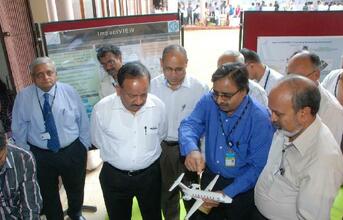
Dr Harsh Vardhan at CSIR-NAL
Appreciating the efforts of the only aerospace laboratory in the civilian sector, CSIR-NAL, Union Minister of Science and Technology and Earth Sciences and Vice-President, CSIR, Dr Harsh Vardhan urged scientists of National Aerospace Laboratories of CSIR to work hard to make the Prime Minister's ‘Make-in-India' programme a success. He says that Aerospace and Defence have been identified to be at the heart of ‘Make in India' and with more than five decades of experience of providing indigenous technologies to strategic sectors, CSIR-NAL is uniquely poised to underpin Prime Minister Narendra Modi's call to raise the percentage of domestic procurement from 40 percent to 70 percent in the next five years.
Being in the country's first public-private partnership with Mahindra Aerospace, CSIR-NAL has developed the 2-seater HANSA in 2000, the 14-seater SARAS in 2004, and the 5-seater CNM-5 in 2011. Reminding this, DR Harsha Vardhan further emphasised the need for increased linkages with private industry that would enable quick commercial realisation of the developed technologies. He called for greater synergy towards meeting both strategic goals as well as spin-off civilian products.
Speaking to the scientists, Dr Harsh Vardhan pointed out that Aerospace and Defence is globally a very highly competitive area, defined by technology denial regimes and highly proprietary systems. Further, he remarked that aerospace is an area marked by large investment and long gestation periods but nevertheless it is imperative to develop streams of innovation that provide significant long-term payoffs in terms of import substitution as well as cutting-edge technologies.
He observed that it was this far-sightedness in supporting aerospace research and development with the establishment of CSIR-NAL in 1959 that resulted in its key technology successes for the strategic sector like carbon fibre composite airframe components and Fly-by-wire Flight Control systems for the Tejas light combat aircraft programme, which were all denied under the technology control regime.


























